Európe | Liner notes
[6] Hüseynî taksim / Improvisation on the oud
[7] Endülüs / Hüseynî-Aşîran yürük semâî
[8] Kairos / Stankina
[9] Manastırka / Poustséno / Pušteno
[10] Isfahân-Kürdî taksim / Improvisation on the violin
[11] Yol / Isfahân-Kürdî saz semâî
[12] Trandafirul rău tînjeşte / Doină
Other releases by Kairos Collective
Contact us
Introduction
The abduction of Europe
Doesn’t your family have at least one member who always causes problems? A tyrant grandfather who is feared by his grandchildren? The proverbial wicked mother-in-law? Or maybe a nephew who charms his mother—your sister!—into loans that are never settled? Repeatedly? A querulant stepdaughter who puts your son up against your wife? Somebody who somehow always manages to make others take sides, even the ones who don’t really want to? Well, I think today’s problem with the extended European family is that we’ve elected such people president.
Presidents who define an us and a them, and make us judge rather than enjoy their habits, and believe that they will take something from us. Presidents feeding on us fearing others, to rise to power they won’t ever want to give back to us, making us fall—again—for one of the oldest tricks in the book. Presidents who manage to make a union divisive and get away with it. Presidents who can’t agree on caring for our planet but do join hands in treating refugees atrociously, which to me is one of the clearest symptoms of what will make Europe small again if we don’t watch ourselves. Presidents who have clearly forgotten that a divided Europe kills.
The thing is: this is not us. We live in a great place, where travelling a thousand kilometres in any direction will bring you into another world. Where cultures meet and blend, and beautiful things happen. Where northern, southern, western and eastern traditions are not mutually exclusive, but form the far ends of a continuum. A continent that can easily absorb some of them. This Europe is what inspired me to put this set of compositions together and give this album this name. I don’t actually think that music as such, except by association or because of lyrics, can or should be political. But I do believe that the combination of the right music and open minds is a perfect antidote for this bad case of misanthropy that we seem to have contracted, just to remind ourselves that we are better than that!
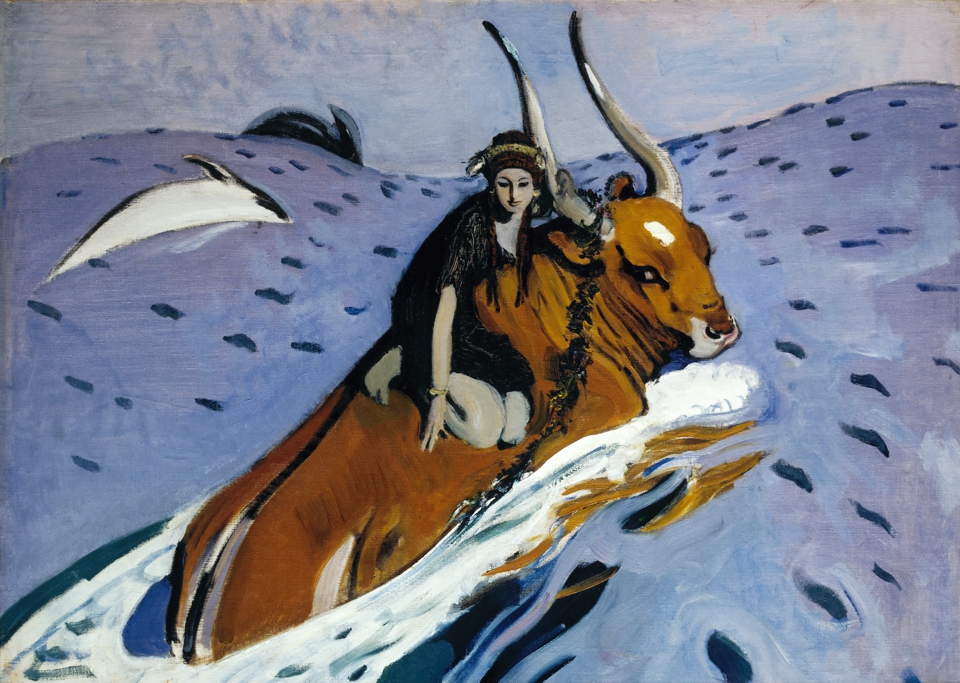
‘The Abduction of Europe’ (1910) by Valentin Serov (1865-1911).
About this album
These compositions jointly represent nostalgia as well as an homage to the three persons who taught me most of what I know about music. First and foremost my father Albert van der Meulen (1940), with whom I played from my early youth. The outro of the album is an old recording of him playing the accordion, and the notes to that track will tell you that my interest in the type of music featured here is an inevitable result of my family history. The second person from whom I learned a lot, albeit mostly indirectly, is the late musician and ethnomusicologist Wouter Swets (1930–2016), who introduced music from the Balkans and the Middle East to Dutch audiences and educated two generations of musicians in these styles. The notes to [2] and [3] refer to his work, and those to [12] tell you about the relationship between him and my father, one of his first students. The third person I would like to honour is master musician and composer Ross Daly (1952). I have been writing music in south-eastern European idioms intermittently since my teens, but around 2010 it became obvious to me that I wouldn’t be able to move beyond the ability to write somewhat catchy tunes without some sort of guidance. In previous years I had been pushing harmony out of the music I play, and I can now say that I was intuitively searching for its modal fabric. So in 2011, I started doing seminars in modal composition with Daly at Musical Workshop Labyrinth in Houdetsi, Crete. Everything fell in place.
Fully aware of the fact that I still have vast areas to explore, I wrote some compositions in classical Ottoman forms, and my first album Pîrî Reis (TouMilou Records #1, 2017) features six of them. With this second album Európe I revisit the type of repertoire I started out with, but now armed with what I learned about modality, and also with a completely different view on harmony and accompaniment. Daly defined the genre of contemporary modal music, which in its turn greatly helped me to define my own relationship with the modal traditions I have loved since I was born, but was not born into, and therefore cannot represent. I do not pretend to add to the traditions I drew from, and therefore contemporary modal music is a perfect, self-explanatory umbrella.
Európe was recorded live in about three days: everybody played together (except the rek in [11], which was overdubbed) in the same room (except the pandeiro in [5] and [9] and the voice in [3], which were recorded in a separate booth for technical reasons). Recording in this way reduces the editing possibilities but brings a feeling and liveliness that to me is irreplaceable.
I recorded Pîrî Reis with some of Greece’s finest musicians, and I am very glad that they wanted to join me for a second time, under the occasional name Kairos Collective. There is one sad exception: oud player Yorgos Mavromanolakis (‘Mavros’) passed away on 17 July 2017 at the age of only 39 years. Yorgos had joined the previous project in a fairly late stage. He told me that he caught up by taking his oud to the park every day to practice, so he came to the rehearsal sessions very well prepared indeed. Even though I didn’t actually witness this, the way I imagine him practicing, outside, on a bench, between the trees, is a very dear memory that also clearly illustrates his dedication. Equally dear is my memory of him repeating, inside and outside the studio, “Michiel! I am so happy that we are doing this!” His enthusiasm really shines through in his playing. In the introductory oud taksim of Pîrî Reis’ track [4], a Dügâh saz semâî, you will hear Yorgos at his very best. Dear Yorgos, I am very grateful that you shared that with us, and equally sad that we won’t be able to do this again.
Michiel van der Meulen
Heraklion, 15 January 2019
Track notes
[1] Hebros / Hüseynî karşılama
Composition: Michiel van der Meulen | Makam: Hüseynî | Usul: aksak (9/8, 2-2-2-3) | Musicians: Harris Lambrakis (ney), Giorgos Papaioannou (violin), Manolis Kanakakis (kanun), Taxiarchis Georgoulis (oud), Nikos Papaioannou (cello), Michiel van der Meulen (tambura), Marijia Katsouna (bendir)
This piece could have been played monophonically, but I added a very basic chord accompaniment so that it connects the strictly modal pieces [2, 3, 5, 7, 11] with the ones that have elementary harmonisation [8, 9]. The instrument used for that purpose, a Macedonian tambura, is a long-necked lute that has four strings in two double courses usually tuned A-A/D-D. It can be a melody instrument, with or without using the lower string as a drone, or an accompanying instrument, playing progressions of dyads. I consider it ideal for modal accompaniment. You can stick to playing fourths and fifths, avoiding clashes with microtonality, and throw in occasional seconds, thirds, sixths or sevenths to add colour.
Hebros is the ancient Greek name for the river that is now called Maritsa (Марица) in Bulgaria, Evros (Έβρος) in Greece and Meriç in Turkey. Its catchment spans most of the larger Thrace region, where eastern modality and western harmony meet and mix beautifully. The river used to connect Byzantium with Middle Europe as a trade route, but recently got to be known abroad mainly as an obstacle for Middle-Eastern refugees on a northern route to Europe. Unfortunately so.
[2] Diaspora / Isfahân-Kürdî peşrev
Composition: Michiel van der Meulen | Makam: Isfahân-Kürdî | Usul: hafif (32/4, 4-4-4-4) | Musicians: Harris Lambrakis (ney), Giorgos Papaioannou (violin), Manolis Kanakakis (kanun), Taxiarchis Georgoulis (oud), Nikos Papaioannou (cello), Marijia Katsouna (bendir)
We are about to re-issue a Dutch book on Turkish art music that the late Wouter Swets wrote as background material to a series of radio lectures he gave on that topic in the mid-1980s. Swets (1930–2016) was a reputed ethnomusicologist and musician from The Hague, who specialised in the related musical traditions from the Balkans and Asia Minor, and is considered by many the godfather of world music in the Netherlands (even though he disapproved of the term). I added a section to his book that complements the original chapter on the history of Turkish art music with the thirty years of development that had passed since the first edition’s release in 1986, as well as a selection of scores that illustrate Swets’ composing and arrangement work. When making that selection, I studied his Isfahân-Zemzeme İlahî «Ben yürürüm yane yane», as well as the saz semâî and peşrev compositions by which the Greek-Ottoman composer Lavtacı Andon (?–1915?) introduced and defined this particular makam. Isfahân-Zemzeme is makam Isfahân making a conclusion by modulating to Kürdî through Sabâ Zemzeme. Swets, however, does not use Andon’s progression, but made a concluding modulation resembling that of makam Hüseynî-Zemzeme instead, without Sabâ flavours. When playing with these ingredients, a new makam appeared that moves from Isfahân to Kürdî, in a way that sets it apart from both Andon’s blueprint of Isfahân-Zemzeme and Swets’ interpretation of it. Tradition dictates that a new makam is introduced with (at least) a peşrev and a saz semâî; both are included here (see also [10] and [11]).
In geographic terms, Isfahân-Kürdî, corresponds to a western trajectory of the Silk Road network, which to me symbolizes the very interaction between western and eastern musical idioms that the compositions on Európe drew from. In a less strict sense geographically, a westward route could also symbolize the current refugee drama resulting from the wars in the Middle-East. With all of that in mind, the Isfahân-Kürdî peşrev and saz semâî are titled Diaspora and Yol (road), respectively.
Explanation of makam Isfahân-Kürdî
Introduction: Isfahân-Kürdî, introduced here as a new makam, was inspired by Isfâhân Zemzeme, a makam created by the Greek-Ottoman composer Lavtacı Andon (?–1915?). Isfâhân Zemzeme is an ascending-descending compound of makams Isfâhân, Sabâ Zemzeme and Kürdî, the latter two used for the conclusion (in that order). Isfâhân-Kürdi is a similar compound of makams Isfâhân and Kürdî, leaving out the modulation through Sabâ Zemzeme and putting more emphasis on Kürdî flavours.
- Tonic: dügah (A)
- Behaviour: ascending-descending
- Dominant: nevâ (D)
- Leading tone: rast (G)
- Accidentals: segâh (B1 koma flat)
- Construction: makam Isfâhân in its original location, conclusion in Kürdî.
- Tonal material: dügâh, segâh, çargâh, nevâ, hüseynî, acem, gerdâ-niye, muhayyer; dügâh, bûselik, nim hicâz, nevâ; dügâh, kürdî, nim hisâr, nevâ, nim hisâr.

Description: Melodic progression starts around the dominant (nevâ), either with the Uşşak flavour on dügâh, or the Nişâbûr flavour on bûselik; the Rast flavour on dügâh is possible as well. These flavours alternate as main compounds of makam Isfâhân. The conclusion is made by playing a Kürdî movement on dügâh, preferably using nim hisâr in the final cadence. In the high register, a Kürdî tetrachord on muhayyer may be added to the Bûselik pentachord on nevâ, resulting in the Bûselik scale on the dominant.

Seyir means melodic pathway, but may also refer to a mini-composition that highlights behaviour and characteristics of a given makam, which for that purpose needs to be stripped down to its bare essentials. Seyir compositions are created for educational purposes only and not intended to be performed onstage, even though the ones written by skilled composers can be beautiful in their own right. A pdf score of the below Isfahân-Kürdî seyir kan be downloaded here.
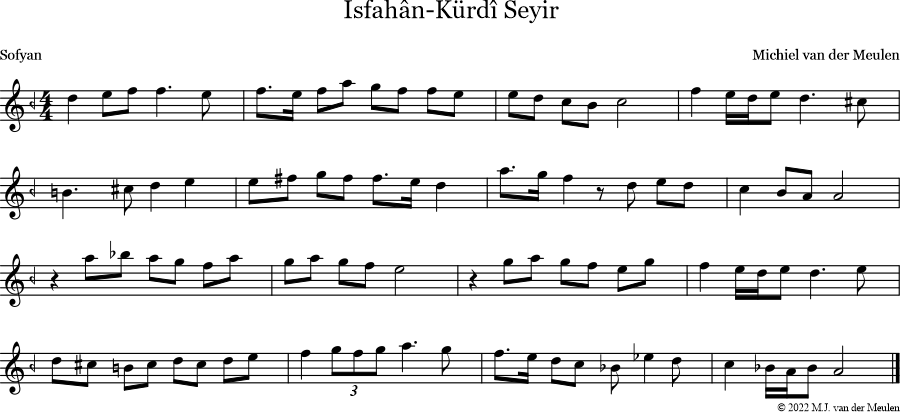
[3] Dali znaeš pomniš li / Kürdîli Hicâzkar Rumeli şarkı
Arrangement: Wouter Swets, Michiel van der Meulen | Makam: Kürdîli Hicâzkar | Usul: aksak semâî (9/8, 3-2-2-3) | Musicians: Roel Sluis (vocals), Harris Lambrakis (ney), Giorgos Papaioannou (violin), Manolis Kanakakis (kanun), Taxiarchis Georgoulis (oud), Nikos Papaioannou (cello), Marijia Katsouna (bendir)
The one version of this song I know is one of my favourite tracks by Dutch ensemble Čalgija, which was released on their album Music from the Balkans and Anatolia #2 (Pan Records PAN 2007CD, 1991, track [3]) and also features on the album Unforgotten (Pan Records PAN 2056 & TouMilou Records #4, track [3]). The aforementioned Wouter Swets (see notes on [2]), founder and leader of the ensemble, based his arrangement of the song on a transcription he found in the book Jugoslovenski muzički folklore II (Prosveta, Beograd, 1953). Swets described how songs like this one were brought to Lazaropole (North Macedonia) from far away by returning emigrants, where the melodies they had learned abroad would become part of the folkloristic repertoire, gradually losing their original characteristics. This particular song is most likely based on or inspired by a şarkı (secular vocal form in Turkish art music) in makam Kürdîli Hicâzkar. He restored the seyir (melodic progression) of this makam accordingly, and added an aranağme (ritornello). I concur with Swets regarding the song’s roots, but thought the approximation of the presumed original could be taken one step further. I rearranged the song in usul aksak semâî (10/8), which fits the phrasing very well, and added a coda section. I am very happy that Čalgija’s original singer Roel Sluis (1950) agreed to participate in the recording. Thanks are also due to Goran Stalevski (pesna.org), for correcting the transcription, translation and transliteration of the lyrics.
Lyrics
Дали знаеш помниш ли, аман аман
кога бевме малечки, аман?
Во гул бавче седевме, аман аман
под гул црвен трендафил, аман
Трендафил ни капеше, аман аман
на нас двата пагаше, аман
Ние двата беревме, аман аман
лицето си мазевме, аман
Transliteration
Dali znaeš pomniš li, aman aman
koga bevme malečki, aman?
Vo gul bavče sedevme, aman aman
pod gul crven trendafil, aman
Trendafil ni kapeše, aman aman
na nas dvata pagaše, aman
Nie dvata berevme, aman aman
liceto si mazevme, aman
Translation
Do you remember
when we were young?
We sat in the rose garden
under a rosebush
The rosebush dripped
on the both of us
We caught the drops
and rubbed our faces with them
[5] Barbanera / Nihâvend evfer
Composition: Michiel van der Meulen | Makam: Nihâvend | Usul: efver (9/8, 2-2-2-3) | Musicians: Harris Lambrakis (ney), Giorgos Papaioannou (violin), Manolis Kanakakis (kanun), Taxiarchis Georgoulis (oud), Nikos Papaioannou (cello), Marijia Katsouna (pandeiro)
During a stay in Houdetsi, Crete, I heard the extraordinary Catalan musicians Aleix Tobias Sabater and Carles Dénia play the song ‘Qual serà el jorn que la mort no teme?’ (What’ll be the day that death isn’t feared?). It has a very powerful modulation that stuck in my head, and eventually resulted in this piece in makam Nihâvend. In modal terms, the song phrase I liked could be described as a modulation of Hicâz Zîrgûle to Kürdî, which primarily affects the third degree, and gives, in harmonic terms, the feel of a major to minor chord change. The third degree changing back and forth is the only element of the song that eventually remained—in the teslim (refrain) to be precise—so the actual resemblance between inspiration and result is hardly noticeable. But isn’t this how inspiration always works?
The Iberian peninsula, where Sabater and Dénia’s song comes from, is the second great European mixing zone of western and eastern musical idioms, the relative proportions of which roughly correlate with the duration of Moorish rule. The name of this piece, Barbanera (‘Blackbeard’), plays with that idea, referring to both Hayrettin Paşa, nicknamed Barbarossa, the much feared red-bearded Ottoman admiral who frequently raided Spain from North-Africa, and Christos Barbas, a much admired musician who actually managed to conquer Spain – with modal music, that is. It was Christos I was studying with when I wrote this piece. He has no nickname I know of but is distinctly black-bearded.
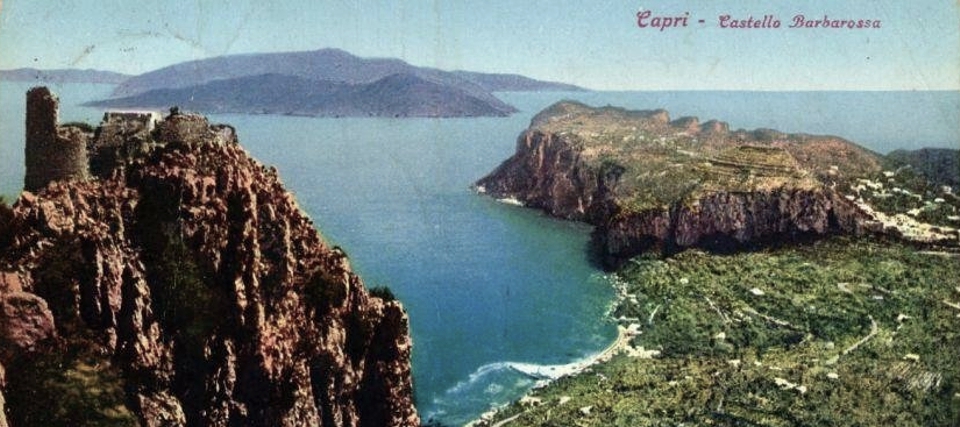
Castello Barbarossa on the island of Capri (Italy).
[7] Endülüs / Hüseynî-Aşîran yürük semâî
Composition: Michiel van der Meulen | Makam: Hüseynî-Aşîran | Usul: yürük semâî (6/8, 3-3) | Musicians: Harris Lambrakis (ney), Giorgos Papaioannou (violin), Nikos Papaioannou (cello), Manolis Kanakakis (kanun), Taxiarchis Georgoulis (oud), Marijia Katsouna (bendir)
The first couple of notes of a composition can be extrapolated in many directions; it is entirely up to the composer to choose which one. Once underway, the piece will start telling where it wants to go, and somewhere down the line it will take over the wheel almost completely. It is the composition that will decide when the composer is done rather than the other way around. I think that being inspired is having a particularly successful dialogue with your piece: you are happy with the directions it is giving you, and the piece appears to be satisfied with your driving skills. Together you are having a great journey, and when destination is reached, you will have become friends.
This piece originated in this way: I set out to compose a yürük semâî in makam Dilkeş-Hâverân which is Hüseynî making a conclusion on the note ırak (fa#). The piece, however, insisted on moving down to hüseynî-aşîran (mi). Eventually I gave in and ended up in the homonymous makam. This occurred in Spain, while studying modal composition at Labyrinth Catalunya. The title Endülüs is the Ottoman name of the Iberian Peninsula.
[8] Kairos / Stankina
Composition: Michiel van der Meulen | Modes: Phrygian, Ionian, tempered Karcığar | Metre: 11/8 (9/8, 2-2-3-2-2, stankina), 7/16 in fourth section (2-2-3, eleno mome) | Musicians: Harris Lambrakis (ney), Giorgos Papaioannou (violin), Manolis Kanakakis (kanun), Taxiarchis Georgoulis (oud), Nikos Papaioannou (cello), Michiel van der Meulen (tambura), Marijia Katsouna (bendir)
This piece I wrote after a failed first attempt to write a saz semâî, during my first seminar in modal composition by the abovementioned Ross Daly, back in 2011. At the time, the Ottoman classical repertoire was fairly new to me, and I couldn’t manage the distinct phrasing of either usul aksak semâî, or the makam of choice. Back home I wrote this composition in a completely different style but in the same structure—ax-bx-cx-dx: four different verses (hâne), the fourth in a different metre, and a refrain (teslim)—to get this sense of failure out my system. I also decided to keep working on modal composition, which has proven to be a great, immensely fulfilling journey.
Kairos (Καιρός), in ancient Greek mythology, is the personification of the right moment, the time to act or an opportunity to be seized. It also means time as it is experienced, i.e., non-linearly, unlike Chronos (Χρόνος), which is time as measured. To me, the concept of Kairos is important. Experiencing it requires you to live now, and allowing yourself to be guided by the spur of the moment from time to time, rather than by your calendar. As quite a few people will be able to confirm, I have trouble with keeping to schedules. But I had perhaps my most Kairotic moment at the age of 17, during the split second I first saw a girl and decided I wanted her to be mine (and vice versa). That girl is now my lovely wife. She likes this piece very much and I cannot but dedicate it to her.
Kairos is to me a clear example of what contemporary modal music is: its phrasing and rhythm draw from music from various south-western Balkan regions, but the piece is not in any way part of the traditions found there. The final section just happened spontaneously during the rehearsals. Instead of simply going back to the refrain, the musicians used its theme for a very atmospheric outro.
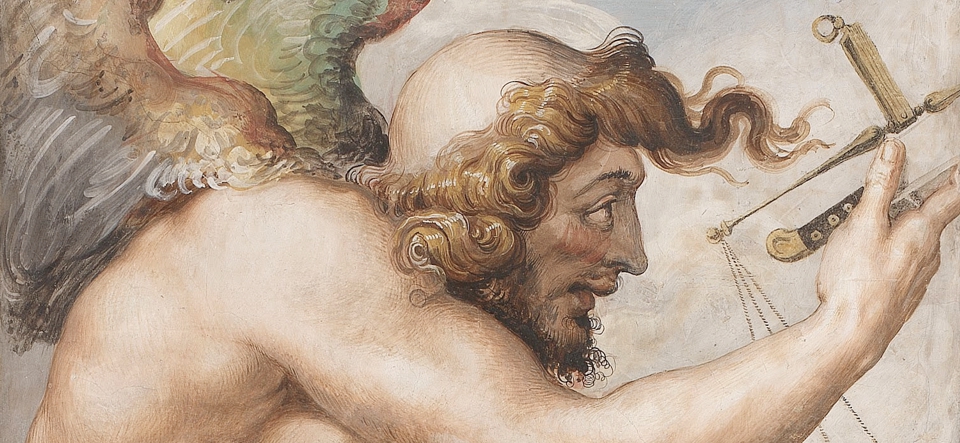
Detail of ‘Time as Occasion’ (Kairos; 1543-1545) by Fransesco de’ Rossi (1510-1563); fresco in Palazzo Vecchio (Florence, Italy).
[9] Manastırka / Poustséno / Pušteno
Composition: Michiel van der Meulen | Modes: folkloristic forms of makams Hüseynî, Hicaz and Kürdî | Metre: 16/16 (2-2-2-3-2-2-3, poustséno/pušteno) | Musicians: Harris Lambrakis (ney), Giorgos Papaioannou (violin), Nikos Papaioannou (cello), Manolis Kanakakis (kanun), Taxiarchis Georgoulis (oud), Michiel van der Meulen (tambura), Marijia Katsouna (pandeiro)
This piece* is inspired by a melody I once transcribed from memory, one that I think I learned from my father, who neither remembers who taught him, nor where the song is from, nor what it is called. Based on the type of melody and rhythm we agreed it must be Macedonian. It might very well be that the song as we used to play it does not actually exist: in criminological terms the chain of evidence is hopelessly compromised, and I must admit that I never found a melody sounding much like it. Pedigree set aside I really like its metre, which belongs to a family of dances that exists in the Macedonian region, and is referred to as pušteno (пуштено) in North Macedonia and poustséno (πουστσένο), pousténo (πουστένο) or levendikos (λεβέντικος) in Northern Greece. The piece may sound traditional to western ears, but the people who live in the region would find the opposite. This is partly due to the modal instrumentation, which brings coherency to the fairly eclectic contents of this album. I thank Harris Lambrakis for clarifying a rhythmic issue. Once that was sorted the musicians created the intro, which will immediately take you to mountainous Northern Greece, and very clearly exposes the Epirotic family roots of the Papaioannou brothers.
The definition of Macedonia, by the way, is a rather touchy subject that is best left alone by non-natives of the states involved. ‘Manastırka’ refers to a city and region that has been inhabited for centuries by Slavs who call it Bitola (Битола), Albanians who call it Manastir, Aromanians/Vlachs who call it Bitolia, Greeks who call it Monastiri (Μοναστήρι), all of whom ruled by Ottoman Turks who called it Manastır. Between 1864 and 1912, Manastır was the capital of the homonymous vilayet, a first-level administrative division of the Ottoman Empire. The basis of that division was geographic rather than ethnic, because Europe’s current exclusive relationships between peoples and countries has only existed since the empires fell and nation states were established. The Ottomans were rulers of territory and its inhabitants regardless of their ethnicity, not of peoples and their countries. Anyway, ‘Manastırka’ refers to a region where at least the metre must be somewhat familiar. For those who are unsatisfied with this etymology, the name could however also refer to Šljivovica Manastirka (Шљивовица Манастирка), an internationally famous Serbian brand of Slivovitz having 45% of a substance that has a great and proven potential to unite us all.
_______
* Manastırka, performed by a different ensemble, also features on the album Erato (2022).
[11] Yol / Isfahân-Kürdî saz semâî
Composition: Michiel van der Meulen | Makam: Isfahân-Kürdî | Usul: aksak semâî (10/8, 3-2-2-3) | Musicians: Harris Lambrakis (ney), Giorgos Papaioannou (violin), Manolis Kanakakis (kanun), Taxiarchis Georgoulis (oud), Nikos Papaioannou (cello), Marijia Katsouna (bendir), Vagelis Karipis (riq)
On two occasions in 2018, I rescheduled a flight back home from a seminar so that I could attend an unscheduled performance of this piece by orchestras formed by Ross Daly. This first happened in Cardedeu, Catalunya, where it was a matter of postponing my flight to the same one a day later. The second time, in Iraklion, Crete, was a bit more complex. I changed my morning flight to the last one of the day. One-and-a-half hours before the concert and about three-and-a-half hours before departure, I went to the airport and asked a ground steward whether I could check in my luggage a bit earlier. He first said no, but when I told him I needed to attend a concert between check-in and boarding (“you mean now!?”), he saw the fun of it and made it happen. This, by the way, beautifully epitomizes Greek mentality and everything I like about the country. I rushed back to the venue, where the concert started about half an hour late, putting me on a rather tight schedule. I listened to my piece and had to start running to a taxi as soon as the applause began. I made it just in time, just as I like it.
There is nothing quite like hearing good musicians play a piece you wrote, and I actually prefer it over joining in. A piece originating in your mind, being transferred to paper, then to other people’s minds, to be subsequently brought to life by their hands, is sheer magic. The way that Harris Lambrakis plays the ney on this recording, with an Arab touch, made both me and him think of a riq (a small Arabic tambourine). We immediately called Vangelis Karipis who played a riq track that lifts the piece and beautifully complements Marijia Katsouna’s bendir. See [2] for an explanation of makam Isfahân-Kürdî.
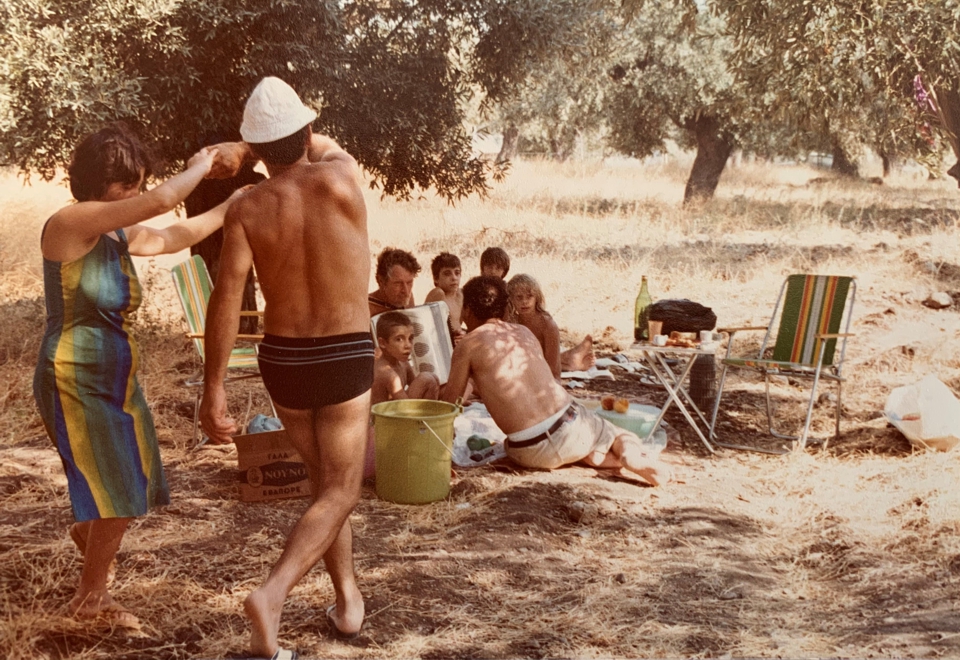
Formative childhood experiences: Albert van der Meulen playing the accordion. during a break from palaeontological fieldwork in Greece (early 1980s). Photo: Joke van der Meulen.
[12] Trandafirul rău tînjeşte / Doină
Arrangement: Albert van der Meulen | Mode: folkloristic, tempered forms of makams Rast and Nikrîz | Metre: free time | Musician: Albert van der Meulen
This piece represents two related things that are dear to me: making music with my father Albert van der Meulen, and my childhood memories of Greece (even though the melody is not Greek at all). Born in the Dutch East Indies in 1940, my father’s early youth was marked by imprisonment in a Japanese concentration camp and the ensuing Indonesian National Revolution. Happier years followed after his parents moved to Singapore, but when the Maria Hertogh Riots of 1950 echoed the onset of the colonial wars in Indonesia, my grandmother decided to move back to her home region in the Netherlands, taking my father and his sister (1947) with her. My grandfather stayed in the Far East to work. To a boy raised in the tropics, rural Friesland was cold, wet and in many ways terribly bland. Beyond the perhaps more obvious things, he missed the music: not the type made by and for Europeans, but the local music he had heard on the streets, or being played or sang at home by his babu (nanny) and her husband.
Being musical, my father was given an accordion, but he was never happy with the repertoire used by his teachers. The first music that really appealed to him after his return to Europe was Balkan music, to which he was introduced by the abovementioned Wouter Swets. After he joined Swets’ first orchestra Čalgija in the mid-1960s, he would never play anything else ever again, eventually becoming very good at it.
Being unhappy with the repertoire used in the violin lessons I received, I started playing with my father at the age of about nine. It was an inevitable repetition of history. I would not even have existed without Balkan music in the first place, because when my mother heard that her aspiring boyfriend and later husband played the accordion, she almost broke up with him, refusing to be exposed for the rest of her life to the very type of repertoire my father had rejected in his youth. But she stayed on when she was told what he played, knowing Balkan music from Swets’ radio lectures (see [2]) in which she had actually heard my father play, demonstrating the exotic aksak rhythms Swets was explaining to his unknowing listeners.
My father was a geologist and most of our family holidays consisted of my mother, sister and me joining him on his palaeontological field campaigns in the Mediterranean. The ones in Greece, which took place from the late 1970s to early 1980s, presented the first opportunity to me to hear his music in its proper setting. In tavernas, after dinner, I observed my father’s playing being appreciated as something natural, just as it had always been perfectly natural to myself, while most people back home—even the appreciative ones—never seemed to really get beyond its exoticism.
Things fell into place. My fondest childhood memories are of long summer evenings with good company, food and music, and I think reliving such evenings is what I basically pursue in my own music, ever since I started making music together with my father. He was at his best playing music from Slavic and Romanian Balkan regions where the accordion is a traditional instrument, which for obvious reasons is less suited to modal, microtonal music. This is why I decided to add this old, creaky recording of a doină (Romanian ametric piece, mostly sung, occasionally instrumental) that he liked to play. This one is inspired by what my parents considered ‘their song’: ‘Trandafirul Rău Tînjeşte’ (‘the rose withers away’, a love song about longing, as featured on the album Trésors Folkloriques: Rencontre Avec La Roumanie – Banat, Electrecord STM-EPE 0751, 1976, track B3/12). My father did not play the original melody, but used its general structure to create something between an improvisation and a composition of his own.

